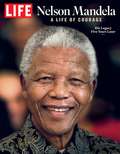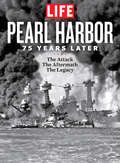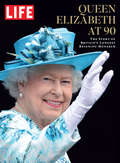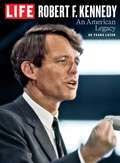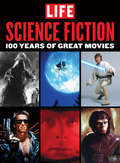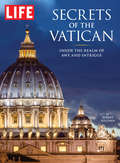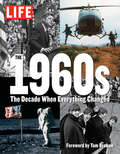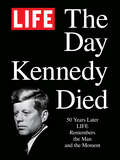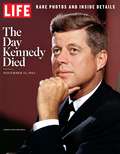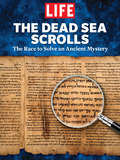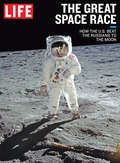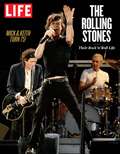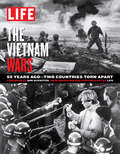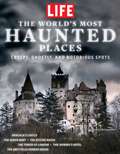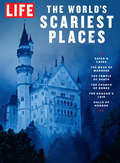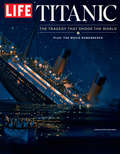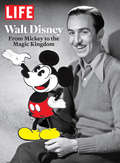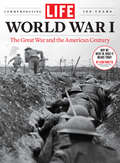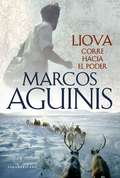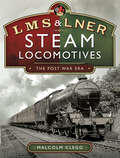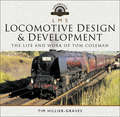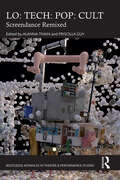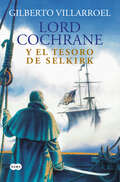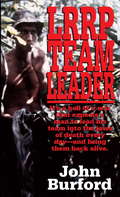- Table View
- List View
LIFE Nelson Mandela: A Life of Courage
by The Editors of LIFEFrom his youth as the leader of rebels to his years as president and elder statesman of South Africa, Nelson Mandela changed the world through his messages of peace and reconciliation. Rediscover the amazing journey of this inspiring leader in LIFE Nelson Mandela—a photographic biography and Special Edition featuring unforgettable images and insightful text from the editors of LIFE. Follow Mandela throughout his lifelong fight against apartheid and injustice, his 27 years of imprisonment at Robben Island and Pollsmoor, and his triumphant victories as both the first democratically elected president of South Africa and as a Nobel Peace Prize laureate. Dozens of historical photographs show him as a resistance leader with the African National Congress, at his trials, during his time in prison, and in his later years with other world leaders, including Bill Clinton and Desmond Tutu, just to name a few. For decades, readers have turned to LIFE to see, understand, and remember the most important events and people of our time. Let Nelson Mandela show you the remarkable life of an enduring symbol of hope and equality.
LIFE Pearl Harbor: 75 Years Later: The Attach - The Aftermath - The Legacy
by The Editors of LIFELIFE commemorates the 75th anniversary of the attacks on Pearl Harbor.
LIFE Queen Elizabeth at 90: The Story of Britain's Longest Reigning Monarch
by The Editors of LifeQueen Elizabeth II has been called "A Queen for All Times." At 90 years old, she now has eclipsed Queen Victoria's 63-year record to become Britain's longest reigning monarch. She remains the head of state of the United Kingdom, and a group of 16 nations including Canada, Australia, and New Zealand call her queen, and she is the head of the British Commonwealth which includes another 37 countries, including India and South Africa. Throughout her life, she has enjoyed much happiness including a long and happy marriage to Prince Philip, four children, and Silver, Golden, and Diamond Jubilees. Her reign has also been marked by much sadness, including the failed marriages of three of her children, the deaths of close family members and friends, and the markedly difficult death of Princess Diana, which took a toll on both the Royal Family and the nation.Now Life, in a new special edition, takes a nuanced and thoughtful look at the reign of Elizabeth at 90 and what her over-63 years on the throne have meant for her subjects and the world at large, including her early life, the years of World War Ii, her marriage and family, life ruling Great Britain, Windsor family values and much more.With dozens of stunning photos, stories, and analysis, Queen Elizabeth at 90 is a keepsake of both a life well-lived and an historical time on the throne, as well as a captivating collection for any royal watcher.
LIFE Robert. F. Kennedy: An American Legacy, 50 Years Later
by The Editors of LIFEFifty years after Robert Francis Kennedy's assassination, celebrate his legacy with this special edition LIFE Robert F. Kennedy.
LIFE Science Fiction: 100 Years of Great Movies
by The Editors of LIFEExplore the rise of science fiction - the land of time machines, space travel, and lost worlds - and how we became so enraptured by the mystery, wonder, and thrill of a genre. Discover the historical inspiration, creative strategy, and the behind-the-scenes scoop of classics including Star Wars, ET, Jurassic Park and Avatar in an all-new special edition from LIFE, Science Fiction: 100 Years of Great Movies.Included in this special edition is a detailed chronicle of the 20 most iconic movies that helped forge a new identity for a new genre. Through its evolution over the years - beginning in 1902 with George Méliès's Le Voyage dans la Lune to most recent years in films such as Avatar (2009) and The Martian (2015) - Science Fiction has not only endured a changing landscape thanks to the invention of new technology, but has grown a passionate and devoted following. In this celebration of the most iconic Science Fiction films, adventure through the geniuses of Ray Bradbury, H.G. Wells, Steven Spielberg, Stephen King, and George Lucas and delve into worlds of possibility and the future.
LIFE Secrets of the Vatican (LIFE Special Issue Magazine)
by Robert SullivanMini-state, magnificent museum, nerve center of a globe-girdling church, the Vatican is a magnet for millions of people every year. LIFE's cameras capture the opulence, and the spirituality. Learn more about:The Popes who reigned there: the good, the great and the bad.The treasure trove that is the Vatican Museum, The Sistine Chapel: Michelangelo's storied ceiling before and after its restoration. The new world of Pope Francis
LIFE The 1960s: The Decade When Everything Changed
by Tom Brokaw The Editors of LIFEHere are the 1960s: The Summer of Love, the space race, Vietnam, the assassination of JFK, Andy Warhol, the Berlin Wall, the Beatles. From start to finish, this is the decade when everything changed—when we changed. With insightful commentary and hallmark photography from the archives of LIFE magazine, LIFE: The 1960s reveals the turmoil and triumphs of the most tumultuous decade in American history. The shifting people, places, and events are placed in historic context, year by year from 1960 to 1969, and illuminated with award-winning, iconic photos. A thought-provoking introduction by Tom Brokaw spotlights the enduring legacy of these years, powered by the baby boomers and their quest for love, liberty, and equality. Discover the decade as it unfolded.
LIFE The Day Kennedy Died: Fifty Years Later: LIFE Remembers the Man and the Moment
by The Editors of LifeFifty years ago on November 22, 1963, in Dallas's Dealey Plaza, John Fitzgerald Kennedy, the 35th President of the United States, was assassinated while traveling in a motorcade with his wife, Jacqueline. LIFE magazine, the weekly pictorial chronicle of events in America and throughout the world, was quickly on the scene. The Kennedys had been LIFE's story: Jack and Jackie made the cover in his sailboat before they were married and he was a fresh-faced senator from Massachusetts, and the White House doors had remained open to LIFE throughout his presidency: Cecil Stoughton's photographs of Caroline and John-John in the Oval Office, Jackie's tour of the renovation, tense behind-the-scenes moments during 13 days of the Cuban Missile Crisis--all of this appeared in LIFE. The famous Zapruder film, included here unedited, first appeared in LIFE, after being acquired by LIFE's Richard B. Stolley. Stolley also interviewed at the time Dallas police, Kennedy administration officials, members of the Oswald family, workers at Jack Ruby's bar. Jackie's first conversation after the murder was with Theodore H. White for LIFE, and in it she told the American people, for the first time, about the Camelot her late husband had imagined. All of that is revisited in LIFE The Day Kennedy Died, including: An official release of the unedited Zapruder film An essay by Richard B. Stolley on how he exclusively obtained the iconic film for LIFE An essay by Abraham Zapruder's granddaughter, Alexandra, who writes for the first time about how the film affected her family over the generations Personal stories about where they were when they heard the news from Barbra Streisand, Maya Angelou, Jimmy Carter, Tony Bennett, Willie Mays, Sergei Khrushchev, James Earl Jones, John Boehner, Tom Brokaw, Mikhail Baryshnikov, Alec Baldwin, Bill O'Reilly, Dan Rather and many more Rarely seen photos from the TIME/LIFE archive of Allan Grant's photo essay of the Oswald family on the night of the assassination A foreword featuring a conversation with historian David McCullough LIFE's Theodore H. White's famous "Camelot" interview with Jackie (which she gave shortly after the assassination), as well as the story behind the interview and the words that never ran A new essay on 50 years of conspiracy theories by J.I. Baker, author of The Empty Glass
LIFE The Day Kennedy Died: Fifty Years Later: Life Remembers The Man And The Moment
by The Editors of LIFELIFE Magazine presents The Day Kennedy Died.
LIFE The Dead Sea Scrolls: The Race to Solve an Ancient Mystery
by The Editors of LIFEIn the late 1940s, perhaps the greatest archeological find of modern times occurred when Bedouin shepherds unearthed mysterious scrolls in a cave near the Dead Sea, just south of Jerusalem. These documents turned out to be manuscripts-some of them biblical-reflecting the beliefs of a vanished Jewish sect that fled Jerusalem during the time of Christ. But what was the connection between the documents and the ruins of an abandoned nearby settlement known as Qumran? Like some holy, historical cross between Raiders of the Lost Ark and The Da Vinci Code, LIFE's book follows the race to unearth-and decode-the many other manuscripts hidden in the desert caves.
LIFE The Great Space Race: How the U.S. Beat the Russians to the Moon
by The Editors of LifeForged in the cauldron of both Nazi Germany and the Soviet Gulag-and fueled by the development of nuclear weapons during the Cold War-The Great Space Race is an epic drama filled with triumphs and tragedies, both technological and deeply human, that riveted the U.S. even as it seemed the fate of the free world (perhaps even the world itself ) hung in the balance.The book features rare, exclusive photographs and thrilling reporting, reflecting LIFE's insider access to the astronauts, their families, and their missions: Go behind the scenes as John Glenn trains for his historic flight, and marvel with Joan Aldrin as her husband, "Buzz," becomes the second man to set foot on the lunar surface. Join Anne Morrow Lindbergh and her aviator husband, Charles, as they visit the Apollo 8 crew on the eve of their historic holiday mission. Watch from the top of the rocket launcher as LIFE's photographer captures the launch of the first manned trip to the moon....and much more.
LIFE The Rolling Stones: Their Rock 'n' Roll Life
by The Editors of LIFEIn 2018, when both Mick and Keith turn 75, celebrate one of the greatest Rock 'n' Roll bands of all time in the LIFE special collector's edition, The Rolling Stones.
LIFE The Vietnam Wars: 50 Years Ago - Two Countries Torn Apart
by The Editors of LifeLIFE Magazine presents a special on the Vietnam Wars.
LIFE The World's Most Haunted Places: Creepy, Ghostly, And Notorious Spots
by The Editors of LIFELife Magazine presents The World's Most Haunted Places.
LIFE The Worlds Scariest Places
by The Editors of LIFETake an otherworldly world tour of horrifying haunts!This Halloween, visit haunted houses, creepy cemeteries, scary ghost towns, and shocking paranormal hotspots . . . all without leaving the comfort of your own well-lit home.
LIFE Titanic: The Tragedy That Shook the World
by The Editors of LIFEThe tragedy that shook the world.Well over 100 years after the sinking of the Titanic, it remains one of the tragedies that loom large in our collective memories and imaginations, not just for the enormous loss of life, but also for the fact that it shouldn't have happened. From the construction of the ship and its maiden voyage, to its collision with an iceberg in the North Atlantic, the entire, fateful journey is chronicled in LIFE Titanic. This classic Special Edition is filled with stunning photography, authoritative text and archival documents that take you to the time period, and place you below the deck to see the ship's inner workings, imagine the lavish meals served in the dining room, and meet many of the illustrious guests on the RMS Titanic. Amazing photos of the survivors and the aftermath, plus a look at the Titanic's place in our shared history, make this a compelling guide to an unforgettable tragedy.
LIFE Walt Disney: From Mickey to the Magic Kingdom
by The Editors of LIFEDisney World is often referred to as the "happiest place on earth" and the character Mickey Mouse is long ingrained in our collective memory. The Walt Disney Company is one of the largest and most valuable companies in the world. But behind all of that was one ambitious small-town farm boy who failed as often as he succeeded, and finally found worldwide fame - thanks to a cartoon mouse.Throughout the rise of Walt Disney, LIFE magazine was there, covering everything from the first Mickey merchandising to the launch of Walt Disney World in 1971, and now in this all-new special edition, LIFE revisits both the man and the magic in LIFE Walt Disney: From Mickey to the Magic Kingdom. Very few people know that as a young entrepreneur, he struggled with bankruptcy, borrowing money until he had a hit with the Mickey Mouse cartoons in the late 1920s. Beloved movies of today - Pinocchio, Fantasia, and Bambi - bombed when first released, and it wasn't until the astronomical success of Disneyland in 1951 that finally put his company into the black.From early days to troubled times, and successes and failures too numerous to count that bring us all to the World of Disney that we all know and love today, LIFE Walt Disney is a fitting tribute to a creative force that has and will continue to influence countless generations for years to come.
LIFE World War I: The Great War and the American Century
by The Editors of LifeIn 1914, the assassination of Archduke Franz Ferdinand-who was in line for the throne of the Austro-Hungarian Empire-propelled Europe into a war unlike any the world had ever seen. But it would take yet another remarkable series of events for the United States to decide to enter the fray, a century ago in April of 1917. By the time the armistice arrived the following year, empires had fallen and 15 million combatants lay dead. And for the United States, the consequences of the decision to get involved would reverberate throughout would come to be known as the American Century, and still echo today.Includes:How the actions of teenage Bosnian nationalists set the war in motion-and why European leaders could not (or would not) stop itThe birth of modern warfare and the brutal results that came with poison gas, airplanes and tanksAmerican leaders facing a future in which isolation is no longer an optionHow the underprepared U.S. military helped put an end to years of war-and emerged one of the world's great fighting forcesPlus: the Versailles Treaty and the League of Nations and how they failed to avert an even more cataclysmic war two decades later
LIOVA (EBOOK)
by Marcos AguinisEl creador del Ejército Rojo, el líder -con Lenin- de la Revolución Rusa de octubre de 1917, el intelectual que generó la idea de la "revolución permanente", ese es el protagonista de esta nueva obra de Marcos Aguinis. Es el mismo León Trotsky, en su infancia y juventud, el que le permite al autor una proeza literaria: una novela de iniciación que sigue las huellas de una transformación apasionada y que culmina en la construcción de un personaje clave, que cambió la historia del siglo XX. Aguinis nos introduce en una historia fascinante, los entresijos, los claroscuros de un momento único cuya cima es la revolución bolchevique, hito mayor del comunismo. Con naturalidad, el texto se aferra a los oscilantes destellos ideológicos del protagonista y sus circunstancias, pero su trabajo mayor, su delicada orfebrería, es la de descubrir la esencia del hombre por sobre todas las cosas; un hombre con sueños que se pueden trocar en realidad. La acción de Liova (como llamaban a Trotsky de pequeño) nos lleva desde la infancia hasta la cumbre, pasando por los primeros escritos en Odesa, los destierros en Siberia, las fugas por la estepa llena de lobos, su formación a través de media Europa, los amores encontrados y los perdidos, las contradicciones, la familia, las traiciones, los grandes nombres (Máximo Gorki, Lenin, Rosa Luxemburgo) y los gestos de una domesticidad que desarma. Esta novela, provista de una intensidad asombrosa, arroja nueva luz sobre el personaje pero se lee "virtud de todas las narraciones cinceladas por Marcos Aguinis" como un vibrante relato de aventuras.
LMS & LNER Steam Locomotives: The Post War Era
by Malcolm CleggL M S & L N E R Steam Locomotives, is the result of over two decades of photographing steam locomotives in action in many parts of Britain covered by the former LMS and LNER Railway Companies. They were the two largest of the ‘Big Four’ Railway Companies which operated in Britain between 1923 and 1948. The majority of the photographs were taken during the British Railways era between 1948 and 1968. Although the author Malcolm Clegg has a sizeable collection of steam locomotive photographs taken during this period, the photographs which appear in this book are from the private collection of his lifelong friend and family relative, Mr Peter Cookson (a retired school-master), himself a railway historian, author and amateur photographer, who has kindly provided the photographs for publication in this book. Many of the photographs selected are rare and unusual for a variety of reasons which should appeal to railway historians and steam enthusiasts alike.
LMS Locomotive Design & Development: The Life and Work of Tom Coleman (Locomotive Portfolio Ser.)
by Tim Hillier-GravesIn 1958 one of Britain`s greatest locomotive designers died without public fanfare or recognition, mourned only by his family. Yet William Stanier, arguably one of our greatest engineers and his leader, said of him that without his Chief Draughtsman all he achieved with the LMS would not have been possible. How could such a man slip from our view and remain anonymous, although his Princess Coronations, Black 5s and 8Fs are regarded as three of the finest classes of locomotive ever built? And today many survive as stars to grace the ever growing preservation movement.In reality, Tom Coleman was an intensely private and modest man who never sought recognition or commendation. His need for privacy may be one reason why his life has remained shrouded in mystery for so long, but finally his story has been slowly pieced together from a wide variety of sources, many previously untapped. So now we can see for ourselves his great contribution to railway history and recognise his singular talents.
LO: Screendance Remixed (ISSN)
by Alanna Thain Priscilla GuyThis edited collection assembles international perspectives from artists, academics, and curators in the field to bring the insights of screendance theory and practice back into conversations with critical methods, at the intersections of popular culture, low-tech media practices, dance, and movement studies, and the minoritarian perspectives of feminism, queer theory, critical race studies and more.This book represents new vectors in screendance studies, featuring contributions by both artists and theoreticians, some of the most established voices in the field as well as the next generation of emerging scholars, artists, and curators. It builds on the foundational cartographies of screendance studies that attempted to sketch out what was particular to this practice. Sampling and reworking established forms of inquiry, artistic practice and spectatorial habits, and suspending and reorienting gestures into minoritarian forms, these conversations consider the affordances of screendance for reimaging the relations of bodies, technologies, and media today.This collection will be of great interest to students and scholars in dance studies, performance studies, cinema and media studies, feminist studies, and cultural studies.
LORD COCHRANE Y EL TESORO DEL SELKIRK (E
by GILBERTO VILLARROELEl marino más audaz de todos los tiempos regresa en una aventura de piratas. Chile, 1822. Terremoto y maremoto en Valparaíso. Lord Cochrane, almirante de la escuadra chilena, le salva la vida al general Bernardo O'Higgins. A manera de agradecimiento, el Director Supremo revela que una vez estuvo a punto de despedirlo y de ofrecerle, como compensación, el archipiélago de Juan Fernández. Y que, en Robinson Crusoe, la isla principal del archipiélago, el corsario Alexander Selkirk escondió en 1704 un tesoro que nadie ha podido encontrar. Todo indica que el tesoro es una reliquia que Selkirk trajo consigo desde una región del estrecho de Magallanes que los aborígenes llaman Las Montañas de la Locura. Este lugar habría sido el primer hogar en la Tierra de un dios venido desde las estrellas, el inmortal Cthulhu. Intrigado, Lord Cochrane parte hacia Juan Fernández junto a su amiga Maria Graham y al capitán Eonet. Lo mismo hace un antiguo enemigo suyo, el capitán Gervasio Corrochano, un ex oficial de la Armada española que ahora está al mando de un buque pirata, el Águila.
LOVE AND MAYHEM
by Jan Coffey May McGoldrickThe great hall in Fleet Tower is quite the lively place. The McCalls are preparing for a wedding, and if that means unexpected arrivals, murder, mayhem, and chaos, all the better in this "laugh-out-loud comedy." Try getting married when your betrothed can wield an iron pot with deadly accuracy, her mad uncle thinks he's William Wallace, and her two maiden aunts can't finish a sentence—or a thought—on their own… Such are Sir Iain Armstrong's troubles when he sets out to wed Lady Marion, a convent-raised spitfire. All Iain wants to do is fulfill their fathers' wishes, appease two royal courts, and do what is best for the future of Scotland by putting an end to all the troubles in his part of the Borders. All she has to do is agree to marry him, which is the last thing on her mind when Iain arrives at the convent. She won't be taken without a fight. And even when Lady Marion realizes that Iain is a man of courage, intelligence, and seductively powerful shoulders, will her eccentric family do what her temper tantrums, willful ways, and pride have so far failed to do—and drive him away forever?
LRRP Team Leader: A Memoir of Vietnam
by John BurfordVietnam, 1968. All of Sergeant John Burford's missions with F Company, 58th Infantry were deep in hostile territory. As leader of a six-man LRRP team, he found the enemy, staged ambushes, called in precision strikes, and rescued downed pilots. The lives of the entire team depended on his leadership and their combined skill and guts. A single mistake--a moment of panic--could mean death for everyone.From the Paperback edition.
